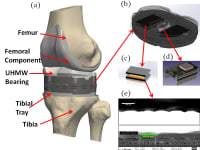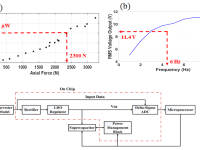
Early detection of incipient failure and excessive wear in knee implants is essential to avoid revision surgery and hence lower medical costs. Self-powered embedded implants sensors could provide a new in vivo capability to reduce these clinical complications. A feasibility study is conducted on a self-powered embedded sensor. Passive body motions are converted to electricity through triboelectric transducers to operate low power load sensors.
The self-powered embedded sensor will be instrumented in TKR between the UHMWPE bearing and the Tibial tray, Figure1. It consists of a package designed with mechanical springs. Two identical triboelectric generators and power digitizing circuit embedded in knee implants inside the package. The generator consists of an upper electrode with micropatterns and the lower electrode of an insulator with reverse micropatterns bonded to another lower flat electrode. The generated power output is proportional to the load applied, where higher power can be generated with more applied force. 6 µW of power was generated under equivalent gait load of 2.3 kN, Figure 2. Since the power generated is proportional to the amount of load being transferred to the knee implant from activities of daily living, it can be used to simultaneously measure the applied forces. Our group designed frontend electronics to digitize the load data that consumes about 4.56 µW. These findings support that triboelectric power generation can be a viable technique for harvesting energy to power load sensing devices for TKR applications.
Under simulated gait loads using the VIVO joint motion simulator, the harvesters are tested at the lateral and medial locations, Figure 3. The durability of the generators for a long-time working condition is examined. The generators in the medial and lateral locations showed a difference in the output that confirms their ability to detect load imbalance. Such capability can be useful in preventing complications after TKR surgeries such as misalignment, instability, and excessive wear. In addition, by using Titanium material for the triboelectric generator layers, we address the biocompatibility concern and maximize the power outputs.
Self-powered embedded sensors could process measurements, store results, and communicates them noninvasively to the surgeon or therapist who can use such measurements to extend the lifespan and improve the function of implants and hence minimize cost and patient recovery.
-
Awards
-
 2019 Top 100 Entries
2019 Top 100 Entries
Like this entry?
-
About the Entrant
- Name:Alwathiqbellah Ibrahim
- Type of entry:teamTeam members:Alwathiqbellah Ibrahim, Shahrzad Towfighian, Ryan Willing, Emre Salman
- Patent status:none








